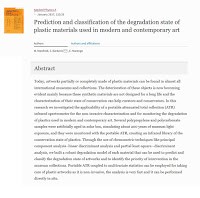News from Diagnostic World: prediction and classification of the degradation state of plastic materials used in modern and contemporary art
Written by Francesca Di Turo
Translated by Sarah Fortunée Tabbakh
 The debate about the conservation of old and modern artwork has been going on for years and has allowed us to understand some of the most common phenomena of degradation of the materials used in art. However, when talking about contemporary art, we realise that things are different and there is still much to know and to examine.
The debate about the conservation of old and modern artwork has been going on for years and has allowed us to understand some of the most common phenomena of degradation of the materials used in art. However, when talking about contemporary art, we realise that things are different and there is still much to know and to examine.
The materials used by today’s artists are very different from what Giotto or Caravaggio used. In this regard, the synthesis of polymers was a true revolution in the art field, leading with plastic. The on-going growth of contemporary art has arisen the problem of its conservation, which is, as you may imagine, very different from an archaeological conservation.
In “Prediction and classification of the degradation state of plastic materials used in modern and contemporary art” by Manfredi, Barberis e Marengo, published on Applied Physics A (available here: DOI 10.1007/s00339-016-0663-x), the authors explore the possibility of using the ATR to analyse in a non-destructive and non-invasive way the plastic materials in art. The publication ends with the chemometric analysis of the results, in order to predict and classify the state of decay of the objects.
ATR stands for Attenuated Total Reflection and is a technique that operates in the mid-infrared (IR) spectrum, measuring the changes that occur in the beam when it comes in contact with a sample. This sample is closely placed to a crystal – called ATR crystal – that guarantees the IR beam undergo a total reflection.
To simplify, after the beam interacts with the sample, we get an attenuated reflection, from which the ATR spectrum is obtained.
This technique could be useful in the Cultural Heritage field not only since it is non-destructive and non-invasive, but also because of the portable equipment which allows for research in situ.
Manfredi and the others also speak about chemiometrics. Briefly, it is a science that applies statistical methods to the chemical data in order to obtain as much information as possible. It can solve descriptive and predictive issues all the while trying to understand the eventual relations between a series of data of a sample.
To study the question in depth and understand how these techniques can be useful to the conservation of contemporary materials, I invite you to read the full article of this post (available at the DOI above-mentioned, or on Researchgate).
For a visual explanation of the ATR, you can watch the Youtube video.
Happy reading and… enjoy the show!


Comments
Post a Comment